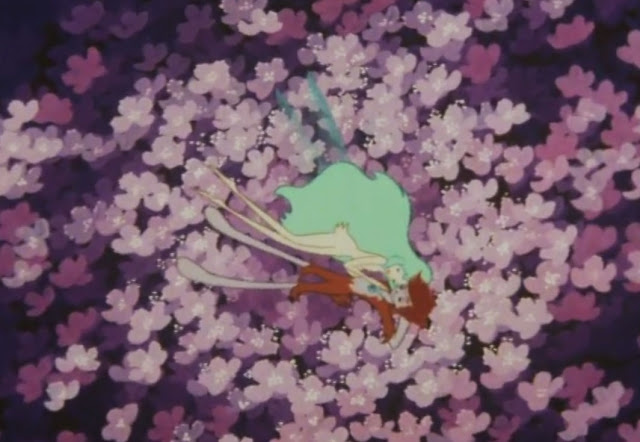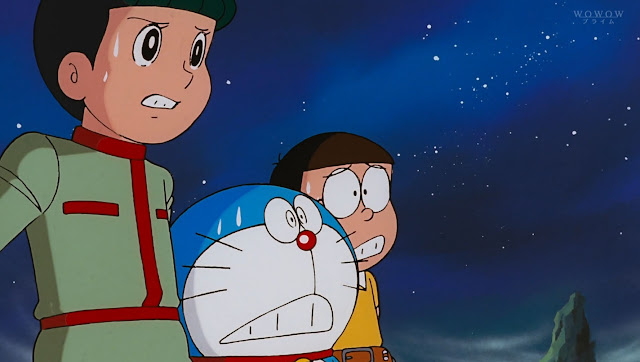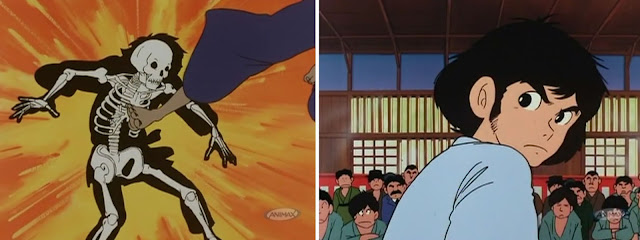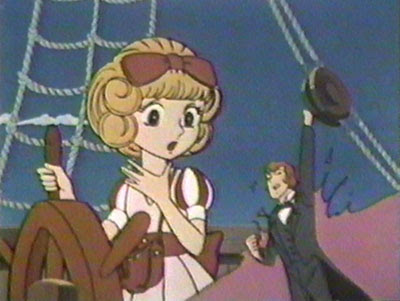Last time here at Let's Anime, we looked at the Japanese anime television of 1981. And let's make no mistake; that was so much TV, you’d think people didn’t have any time to get out to theaters to see anime films. Remember movie theaters? I miss seeing movies in theaters. Anyway, now we're going to take a look at what those people were looking at when they quit looking at their TVs and instead hit their local cinemas to look at anime films, those anime films of 1981. I'm gonna throw some TV movies and specials in here too, just to confuse everybody.
 |
| cosplay at the Gundam I premiere |
Mobile Suit Gundam might have not been a big success in 1979, but the show refused to vanish, and two compilation films were released in 1981 to great fanfare with a third, final film screening in 1982. Much like the success of the earlier Space Battleship Yamato film, this new theatrical re-imagining of a television series put Mobile Suit Gundam on the pop culture map, and soon Gundam model kits would be standard issue in every otaku's survival kit. The movies received both dubs and subs here in North America through a variety of formats and localizers, and you can watch all three right now on Netflix.
The twelfth-century fairy tale of the runaway four musical animals is known in German as "Die Bremer Stadtmusikanten" and was made famous by the Brothers Grimm. Here the story become the basis for Bremen 4 - Angels In Hell, Osamu Tezuka’s fourth TV movie produced for NTV's annual 24-hour charity program Ai wa Chikyū o Sukū ("Love Saves the Earth"), as a space alien sent to save the Earth from war transforms woodland animals into people that just happen to form a rockin' band. Sure, this brings to mind Tezuka’s 1960s series Wonder Three, and why not?
The Hello Kitty company Sanrio front-loaded the rollout of their late 70s magazine Lyrica with a lineup of manga all-stars. Osamu Tezuka’s contribution was Unico, the story of a little unicorn wandering lost through lands of myth and legend. This became a 1981 feature film from Sanrio with animation by Madhouse, and it is an absolute gem, at turns beautiful, haunting, psychedelic, and Margaret Keane-level sugary. Columbia released an English version in the 1980s to home video and cable TV markets, and you can relive your 80s youth today with Unico on DVD and blu-ray from Discotek, and streaming on various platforms.
Sanrio continued its theatrical anime assault with Sea Prince & Fire Child aka the Legend Of Sirius, a Disneyesque re-telling of Romeo and Juliet recast as a romance between children of the gods of the ocean and of fire. Darker and less cutesy than Unico, Sea Prince & Fire Child also received an English-language Columbia release & subsequent Discotek disc.
Slightly less mythological is Doraemon: The Legend of Spaceblazer Nobita, an extra-dimensional adventure where amazing robot cat Doraemon and doofusy human kid Nobita must save the planet Koya Koya from total destruction! Popular throughout the world, Doraemon has yet to make it in the American market, and it's a shame because American kids would really enjoy the knock-offy Star Wars vibe of this feature.
Speaking of total destruction, that’s what Tatsunoko did to the original source material when they adapted Jules Verne’s 20,000 Leagues Under The Sea into Kaitei Daisensou Ai no 20,000 Miles aka Undersea Encounter, sometimes called The Great Navy Battle: 20,000 Miles of Love. In the future, the Emperor Darius seeks to rule the entire world, but is opposed by the Nautilus, captained by Captain Nemo with the help of two castaways Ricky and Ben. Harmony Gold had the license to this TV movie, but their English dub is hard to come by.
Mary Shelley’s Frankenstein got slightly better treatment when Toei adapted her groundbreaking, genre-inventing novel for a TV special. Toei's Kyōfu Densetsu Kaiki! Frankenstein was directed by Toei's all-star tag-team of Yugo Serikawa and Toyoo Ashida, and in true Dr. Frankenstein style, great liberties are taken with the original source material. Part of the Toei/Marvel Comics deal that gave us Hamburger Dracula and Spiderman's giant robot, it's unclear how much this feature draws from the Gary Friedrich/Mike Ploog Marvel comic series. Dubbed by Intersound, this was released on VHS in the United States.
The original master thief battles the original master detective in the Toei TV special Lupin Vs Holmes. The two Victorian-era rivals are pitted against each other in this adventure, based on a 1906 novel that featured Arsene Lupin and a Holmes pastiche that was written by Lupin creator Maurice LeBlanc. This anime has had home video releases in a few countries, but not Japan.
The inspiring true story of Helen Keller became a quadruple-Tony winning stage play, an Academy Award winning film, and also a Japanese anime TV special from TV Asahi. The only version I've ever seen has Finnish narration on top of the Japanese dialogue, making audiences perhaps appreciative of a little silence.
Tchaikovsky's Swan Lake comes to the anime screen in this theatrical version produced by Toei that manages to capture the majesty of the original ballet while also delivering anime-style entertainment. Was the Swan Lake character of "Odille" the inspiration for Vampire Hunter D's Lamika? Hmm. Swan Lake got an English dub from Turner Program Services for the cable TV market and is currently streaming and on DVD from Discotek.
Jack London’s gritty tale of up-North survival and the journey of Buck from former pet into pack leader alpha dog becomes a telefilm from an obviously overworked Toei. Their Call Of The Wild stays reasonably close to the source material and was dubbed by Intersound, achieving immortality through VHS and bargain-bin DVD releases and screenings of "Totally Lame Anime."
In Enchanted Journey, Gliko the chipmunk punk leaves his comfortable tame life and battles his way to freedom in the great north woods. Known in Japan as The Adventure Of Glicko, this animals-in-peril feature is from Studio Korumi and is based on the children's book by Atsuo Saito. The English dub, featuring voice work from Orson Welles and Jim Backus, aired on HBO and got several home video releases.
Last time Let's Anime discussed the TV anime Jarinko Chie aka Downtown Story aka Chie The Brat, the TMS series based on the Etsumi Haruki manga. That TV show was a followup to this Jarinko Chie film, a Toho/TMS/Telecom feature directed by future Ghibli star Isao Takahata. This cinematic adventure of Osaka's scrappy street kid played in theaters in a double bill with our next feature.
Based on the 4-koma gag manga by Masashi Ueda, Furiten-kun is a goofball salaryman appearing here in his only feature film. Furiten's cinema debut consists of 7 short segments and is a production from Oh! Production and the studio that brought you Chargeman Ken, Knack.
Sanshiro comes to Tokyo to become a martial arts champion, becomes the disciple of judo master Yano, and falls in love with Sayo Murai whose father teaches martial arts to police. Along the way Sanshiro battles his rival, the jujitsu fighter Higaki Gennosuke. It's all happening in the Sugata Sanshiro anime TV special (aired June 8) from TMS/Telecom, based on the novel by Tsuneo Tomita and with character designs by Kazuhiko Kato / Monkey Punch!
Joe Yabuki meets his destiny in the boxing ring in Tomorrow’s Joe 2, a feature based on the immensely popular Tetsuya Chiba manga, as directed by Osamu Dezaki with character designs by Akio Sugino. Is this the first time the Dezaki/Sugino team would revisit a property they'd brought to animated life on television?
Space Warrior Baldios, the Ashi Pro/MIC environmental disaster super robot series, wrapped up its 1980 TV series with a 1981 feature that recapped the story and added a downer ending. This got a dub courtesy Peregrine Film which made it to VHS and some UHF TV markets in the States in the late 80s before being license-rescued on disc from Discotek and streaming via Crunchyroll/Retrocrush.
Tetsuro Hoshino re-embarks on the 999 for one last trip through and beyond the galaxy to defeat a revived Mechanized Empire and discover the truth about himself in Adieu Galaxy Express 999: Final Stop Andromeda, in theaters August 1, 1981. This is the second 999 film from Rintaro (Shigeyuki Hayashi) and some might say the movie is a redundant retread of the first 999 picture. However, this gorgeously animated story claims its own visual territory while forcing Tetsuro - and the viewer - to re-evaluate everything they thought they knew about eternal machine life. It’s on several streaming services and you can buy the DVD and Blu-Ray from Discotek.
First TV, then movies; that's our roundup of 1981 in Japanese animation. Of course there are series and films that didn't make the cut due to time and space constraints, the limits of research, and me wanting to get this thing done with before 2021 ends. I didn't even mention the shows that carried over from 1980, like Fishing Sanpei, Tetsuwan Atom, Tetsujin-28, Doraemon, Sazae-san, etc. So if I missed something, and I definitely did, don't blow a gasket. But what are the winners? What are the standout anime titles from forty years back that still have an impact today? What are the anime series that keep kicking around inside my skull after decades, and what therapy exists to make them stop?
Well, Superbook might have had some extra name recognition on account of it being attached to a two thousand year old religion. There's that. However, this simplistic, clunky show achieved syndicated Japanese cartoon eternal life thanks to cable and broadcast runs that lasted decades, scores of different home video releases distributed via the American Christian media ecosystem, and the show's remarkable popularity in former Soviet bloc nations.
Queen Millennia was the last Leiji Matsumoto property to come out of that 'anime boom' era, the last time his mashup of SF, vintage tech, kids and dream girls would manifest itself in Japan's popular culture. The subsequent succession of Matsumoto remakes, reboots, and reimaginings have had varying degrees of artistic and commercial success, but none have become as popular as his late 70s - early 80s adaptations. The 1981 Queen Millennia show would find itself on American TV screens a few years later, uncomfortably Frankensteined together with 1978's Captain Harlock to make Harmony Gold's "Captain Harlock And The Queen Of 1000 Years," the first many of us would see of either series.
1981 was the year Nippon Sunrise's Mobile Suit Gundam came roaring back out of obscurity to remind us all this series was still in the fight for, and would eventually assume, the throne of Robot King. Sunrise and Gundam's success story has helped move Japanese animation out of our small anime-nerd world and into universal popular culture, and the word "Gundam" itself has come to stand for "SF robots" the world over.
Urusei Yatsura showed up to electrify the anime world in October of 1981. This boy-meets-space-alien series inverted shojo manga tropes and built a subversive, stylish, surrealist romantic-SF-comedy anime empire that would influence the entire field for the next decade and beyond.
Some of my own personal 1981 favorites might not have been as earth-shakingly impactful. Adieu Galaxy Express perhaps let the visuals get way ahead of the script, but those visuals make a film that sheds its 70s skin and reveals shining neon colors bursting out of the absolute blackness of space, enormous extra-galactic mechanical contrivances contorting in miles-wide convulsions, and a surprise 2001-style Stargate sequence, all to get Tetsuro to yet another showdown with the Mechanized Empire.
And of course, one of my faves from 1981 is the MIC comedy-adventure Honey Honey, based on the 60s Hideko Mizuno shojo manga. If you blinked in either Japan or the US you might have missed this show, but it still made a few fans.
1981 still echoes in today's animation landscape. Urusei Yatsura's manga is being reprinted in English and the films are getting Blu-Ray releases, while Superbook is still on the air in some markets. Grown up kids still talk about Unico and forming Voltron's Blazing Sword. And while Furiten-kun and Bremen 4 remain obscure, while the anime Frankenstein and the Call Of The Wild have passed into kitsch, and nobody anywhere gets to watch Arsene Lupin Vs Sherlock Holmes, the mobile suit aesthetic of Mobile Suit Gundam has conquered the Earth Sphere along with the real world, one plamodel at a time. So long 1981!
-Dave Merrill
 |
| Ninja Dog says "see you next time!" |
Thanks for reading Let's Anime! If you enjoyed it and want to show your appreciation for what we do here as part of the Mister Kitty Dot Net world, please consider joining our Patreon!
























